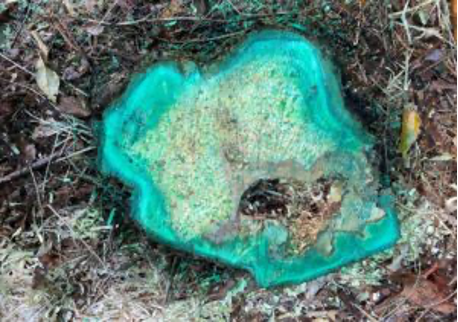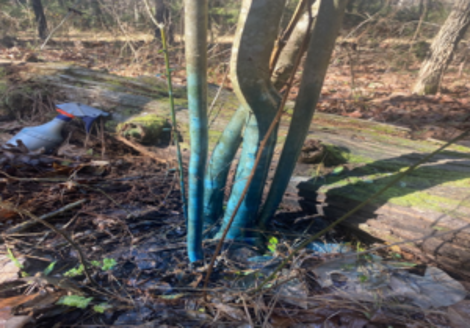Control of Invasive Vegetation Using Manual and Mechanical Techniques
go.ncsu.edu/readext?978201
en Español / em Português
El inglés es el idioma de control de esta página. En la medida en que haya algún conflicto entre la traducción al inglés y la traducción, el inglés prevalece.
Al hacer clic en el enlace de traducción se activa un servicio de traducción gratuito para convertir la página al español. Al igual que con cualquier traducción por Internet, la conversión no es sensible al contexto y puede que no traduzca el texto en su significado original. NC State Extension no garantiza la exactitud del texto traducido. Por favor, tenga en cuenta que algunas aplicaciones y/o servicios pueden no funcionar como se espera cuando se traducen.
Português
Inglês é o idioma de controle desta página. Na medida que haja algum conflito entre o texto original em Inglês e a tradução, o Inglês prevalece.
Ao clicar no link de tradução, um serviço gratuito de tradução será ativado para converter a página para o Português. Como em qualquer tradução pela internet, a conversão não é sensivel ao contexto e pode não ocorrer a tradução para o significado orginal. O serviço de Extensão da Carolina do Norte (NC State Extension) não garante a exatidão do texto traduzido. Por favor, observe que algumas funções ou serviços podem não funcionar como esperado após a tradução.
English
English is the controlling language of this page. To the extent there is any conflict between the English text and the translation, English controls.
Clicking on the translation link activates a free translation service to convert the page to Spanish. As with any Internet translation, the conversion is not context-sensitive and may not translate the text to its original meaning. NC State Extension does not guarantee the accuracy of the translated text. Please note that some applications and/or services may not function as expected when translated.
Collapse ▲This is a synopsis of information presented by Toby Obenauer with the National Parks Service at a NC State Extension educational program in Cleveland County on February 20, 2023 and reiterated by Greg Traywick, County Extension Director & Ag Agent, Cleveland County Center
An invasive species is an organism that is not indigenous, or native, to a particular area. Invasive species can cause great economic and environmental harm to the new area. There are many invasive plants that cause problems in North Carolina forests, pasture, fields, and landscapes.
An invasive species is an organism that is not indigenous, or native, to a particular area. Invasive species can cause great economic and environmental harm to the new area. There are many invasive plants that cause problems in North Carolina forests, pasture, fields, and landscapes.
The North Carolina Forest Service lists a number of invasive plants on their website with links to detailed descriptions and photos provided by NC State Extension’s North Carolina Extension Gardener Toolbox. Should you need assistance identifying invasive species or other weeds, contact your local County Extension Center.
Herbicides provide the only practical solution for controlling invasive plants, but they must be selected carefully and applied correctly to produce optimal results. Treatment method, timing, and rate of application are all critical to success. Always read and follow the herbicide label and use the recommended personal protective equipment to ensure your personal safety while mixing, loading, and applying any pesticide.
Other compounds can be added to herbicide mixtures to improve their performance:
- Surfactants aid the herbicide in penetrating the leaf or injured surface. Nonionic surfactants are inexpensive and are always recommended in the control of invasive species (do not use dish detergent).
- Adjuvants improve the performance of an herbicide
- Penetrants allow for herbicide to enter the growth tissue of the plant
CONTROL TECHNIQUES
Cut Stump: Applying a 25-50% solution of herbicide to a freshly cut stump (herbicide must be applied within 5 minutes).
For cut stump applications, ensure the entire cambium is covered in herbicide.
Pros:
- Can be done year-round
- More forgiving during inclement weather
- Generally more successful than other methods
Cons:
- Requires a higher percentage of herbicide
- Requires a cutting tool (chainsaw, pruner, etc.)
- Risk of injury from falling trees
Tips for improving cut stump control:
- Applying a dye to the herbicide mixture will show where the product has been applied and help avoid duplicate treatments or missed treatments when several stumps have been cut in an infested area. An excellent alternative to commercial marker dyes is Rit Navy Blue all-purpose fabric dye, which leaves a visible color on the treated area for quite some time.
- Also spray exposed trailing surface roots to improve herbicide uptake and prevent re-sprouting.
- To eradicate bamboo, cut between the lowest nodes and fill the stem cavity with herbicide. Cover all leaf surfaces with herbicide to insure good intake.
Foliar Treatment:
Applying a 2-6% solution of an herbicide to the leaves of a plant.
Pros:
- Can cover large areas quickly
- Extremely effective on smaller plants
- Requires a smaller amount of concentrated herbicide
Cons:
- Greater chance for off target damage from spray drift
- Weather can severely influence treatment
- Higher possibility of re-sprouting
- Species being treated must have leaves
Tips for improving foliar treatment:
- Cover all leaf surfaces with herbicide to insure good intake.
- Cover the entire plant, especially the top (meristem).
- Always use a surfactant when making foliar treatments.
Basal Treatment:
Applying a 20-25% solution of an oil based herbicide (like Garlon 4 Ultra) with an agricultural oil to the base of the plant
Basal treatment on multi-stemmed Privet
Pros:
- Allows for the herbicide to stay in contact with the plant for a greater period of time
- Does not require cutting/felling larger species
- Delivers a lethal dose of herbicide to re-sprouting stumps
Cons:
- Has the risk of off-gassing the herbicide
- Mess and fumes may be annoying to the applicator
- Cannot be performed when stems/trunks are wet
Tips for improving basal treatment:
- Be sure to treat from the ground several inches upward.
- Apply the herbicide 360 degrees around the stem or trunk of the plant.
Hybrid: Foliar/Basal Treatment:
Mixing 4% Garlon 4 with 4% Methylated Seed Oil (MSO) and applying to the leaves and stems of small trees and shrubs or ground cover.
Works well on:
- Re-sprouting shrubs (privet, autumn olive, bush honeysuckles and multiflora rose)
- Vines (oriental bittersweet, kudzu and wisteria)
- Waxy-leafed ground covers (English ivy, vinca and winter creeper)
Tips for Managing Vines Growing into Trees:
When dealing with invasive vines (oriental bittersweet, wisteria, kudzu, winter creeper, ivy, etc.), ensure that you find the lowest point of ground contact, cut and spray at the lowest point. Then cut as high up as you can. Discard the cut segment.
RESOURCES Based on his years of practical experience, Mr. Obenhauer has compiled a comprehensive set of treatment recommendations for various weed species.






